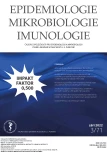Current trends in the epidemiology of malaria
Authors:
E. Pernicová 1,2; M. Krsek 2
Authors‘ workplace:
Centra očkování a cestovní medicíny Avenier. a. s., Brno
1; Ústav veřejného zdraví, Lékařská fakulta, Masarykova univerzita, Brno
2
Published in:
Epidemiol. Mikrobiol. Imunol. 71, 2022, č. 3, s. 175-178
Category:
Short Communication
Overview
Malaria is one of the world’s most important infectious diseases, occurring in many tropical and subtropical countries. The causative agent is a parasitic protozoan of the genus Plasmodium, transmitted to humans by infected mosquitoes. More than 200 million people get malaria every year worldwide, and hundreds of thousands of them, mostly children under 5 years of age, die of it.
Thanks to prevention programmes implemented by various organisations headed by the World Health Organisation (WHO) with the aim of eliminating malaria, cases have been declining in recent years. However, particularly in African countries, malaria continues to be a health and economic issue.
Keywords:
Malaria – Plasmodium – vaccine – prevention programmes
Sources
1. Talapko JI, Škrlec T, Alebić T, et al. Malaria: The Past and the Present. Microorganisms, 2019; 7(6). Dostupné na www:<https://doi.org/10.3390/microorganisms7060179>.
2. Diagnostika, léčba a profylaxe malárie v České republice [online]. 2018-06-30 [cit. 2021-11-23]. Dostupné na www: <https://www.infekce.cz/DPMalarie18.htm>.
3. Laurens MB. RTS,S/AS01 vaccine (MosquirixTM): an overview. Hum. Vaccines Immunother., 2020;16(3):480-489. Dostupné na www: <https://doi.org/10.1080/21645515.2019.1669415>.
4. World Malaria Report 2020 [online]. [cit. 2021-11-23]. Dostupné na www:<https://www.who.int/docs/default-source/malaria/world-malaria-reports/9789240015791-double-page-view.pdf?sfvrsn=2c24349d_5>.
5. ECDC. European Centre for Disease Prevention and Control. Malaria. In: ECDC. Annual epidemiological report for 2019. Stockholm: ECDC; 2021. Dostupné na www:<https://www.ecdc.europa.eu/sites/default/files/documents/AER-malaria-2019.pdf>.
6. Výskyt vybraných hlášených infekcí v České republice, leden – prosinec 2020 [online]. [cit. 2021-11-23]. Dostupné na www:<http://www.szu.cz/uploads/documents/szu/infekce/2020/tabulka_leden_prosinec_2020.pdf>.
7. Nasir SMI, Amarasekara S, Wickremasinghe R, et al. Prevention of re-establishment of malaria: historical perspective and future prospects. Malar J., 2020;19(1):452. Dostupné na www:<https://doi.org/10.1186/s12936-020-03527-8>.
8. Summary of Product Characteristics [online]. [cit. 2021-11-23]. Dostupné na www:<https://www.ema.europa.eu/en/documents/outside-eu-product-information/mosquirix-product-information_en.pdf>.
9. The Lancet. Malaria vaccine approval: a step change for global health. The Lancet, 2021;398(10309):1381. Dostupné na www:<https://doi.org/10.1016/S0140-6736(21)02235-2>.
10. Chitnis CE, Schellenberg D, Vekemans J, et al. Building momentum for malaria vaccine research and development: key considerations. Malar J., 2020;19(1):421. Dostupné na www:<https://doi.org/10.1186/s12936-020-03491-3>.
Labels
Hygiene and epidemiology Medical virology Clinical microbiologyArticle was published in
Epidemiology, Microbiology, Immunology

2022 Issue 3
Most read in this issue
- Unusual Toxoplasma infection of the eye and central nervous system in an HIV-positive patient
- Current trends in the epidemiology of malaria
- Analysis of epidemiological and molecular data from invasive meningococcal disease surveillance in the Czech Republic, 1993–2020
- What risk factors affect hospitalisation for confirmed pertussis cases among infants in the Czech Republic?
